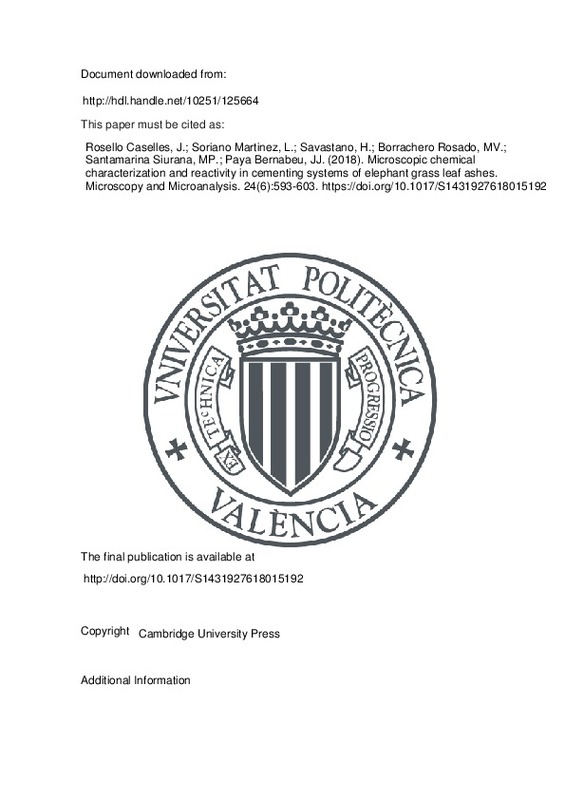JavaScript is disabled for your browser. Some features of this site may not work without it.
Buscar en RiuNet
Listar
Mi cuenta
Estadísticas
Ayuda RiuNet
Admin. UPV
Microscopic chemical characterization and reactivity in cementing systems of elephant grass leaf ashes
Mostrar el registro sencillo del ítem
Ficheros en el ítem
| dc.contributor.author | Rosello Caselles, Josefa
|
es_ES |
| dc.contributor.author | Soriano Martinez, Lourdes
|
es_ES |
| dc.contributor.author | Savastano, H.
|
es_ES |
| dc.contributor.author | Borrachero Rosado, María Victoria
|
es_ES |
| dc.contributor.author | Santamarina Siurana, Mª Pilar
|
es_ES |
| dc.contributor.author | Paya Bernabeu, Jorge Juan
|
es_ES |
| dc.date.accessioned | 2019-09-13T20:01:48Z | |
| dc.date.available | 2019-09-13T20:01:48Z | |
| dc.date.issued | 2018 | es_ES |
| dc.identifier.issn | 1431-9276 | es_ES |
| dc.identifier.uri | http://hdl.handle.net/10251/125664 | |
| dc.description.abstract | [EN] Many agrowastes are being used for energy production by combustion in power plants. This process generates huge amounts of ash, which has a potential pozzolanic activity for blending with Portland cement or hydrated lime. In this paper, the ash obtained from elephant grass (Pennisetum purpureum Schum var. purple) leaves (EGLs) was studied, including the silicon content and its distribution, the presence of other compounds, and in addition, the presence of silica bodies (phytoliths). Combustion temperatures of 450 and 650°C produced an unaltered inorganic skeleton (spodogram), whereas at 850°C, there is a sintering process because of high potassium content in the ash. Phytoliths and different types of hairs were identified, and they contained high percentages of silica. Magnesium (mainly as periclase) was distributed in the most porous parts in the interior of the leaves. The silica can react with calcium hydroxide (pozzolanic reaction) forming calcium silicate hydrates (observed by field-emission scanning electron microscopy and thermogravimetric analysis). Fixed lime percentages at 28 curing days (63%) indicated the high reactivity of EGL ashes in calcium hydroxide pastes due to the pozzolanic reaction. This study demonstrates the possibility of the reuse of ashes from EGLs for the production of environmental-friendly cements. | es_ES |
| dc.language | Inglés | es_ES |
| dc.publisher | Cambridge University Press | es_ES |
| dc.relation.ispartof | Microscopy and Microanalysis | es_ES |
| dc.rights | Reserva de todos los derechos | es_ES |
| dc.subject | Phytolith | es_ES |
| dc.subject | Pozzolan | es_ES |
| dc.subject | Reactivity | es_ES |
| dc.subject | Silica | es_ES |
| dc.subject | Spodogram | es_ES |
| dc.subject | Electron Microscopy Service of the UPV | es_ES |
| dc.subject.classification | BOTANICA | es_ES |
| dc.subject.classification | INGENIERIA DE LA CONSTRUCCION | es_ES |
| dc.title | Microscopic chemical characterization and reactivity in cementing systems of elephant grass leaf ashes | es_ES |
| dc.type | Artículo | es_ES |
| dc.identifier.doi | 10.1017/S1431927618015192 | es_ES |
| dc.rights.accessRights | Abierto | es_ES |
| dc.contributor.affiliation | Universitat Politècnica de València. Departamento de Ecosistemas Agroforestales - Departament d'Ecosistemes Agroforestals | es_ES |
| dc.contributor.affiliation | Universitat Politècnica de València. Departamento de Ingeniería de la Construcción y de Proyectos de Ingeniería Civil - Departament d'Enginyeria de la Construcció i de Projectes d'Enginyeria Civil | es_ES |
| dc.description.bibliographicCitation | Rosello Caselles, J.; Soriano Martinez, L.; Savastano, H.; Borrachero Rosado, MV.; Santamarina Siurana, MP.; Paya Bernabeu, JJ. (2018). Microscopic chemical characterization and reactivity in cementing systems of elephant grass leaf ashes. Microscopy and Microanalysis. 24(6):593-603. https://doi.org/10.1017/S1431927618015192 | es_ES |
| dc.description.accrualMethod | S | es_ES |
| dc.relation.publisherversion | http://doi.org/10.1017/S1431927618015192 | es_ES |
| dc.description.upvformatpinicio | 593 | es_ES |
| dc.description.upvformatpfin | 603 | es_ES |
| dc.type.version | info:eu-repo/semantics/publishedVersion | es_ES |
| dc.description.volume | 24 | es_ES |
| dc.description.issue | 6 | es_ES |
| dc.identifier.pmid | 30324900 | |
| dc.relation.pasarela | S\374510 | es_ES |







![[Cerrado]](/themes/UPV/images/candado.png)

